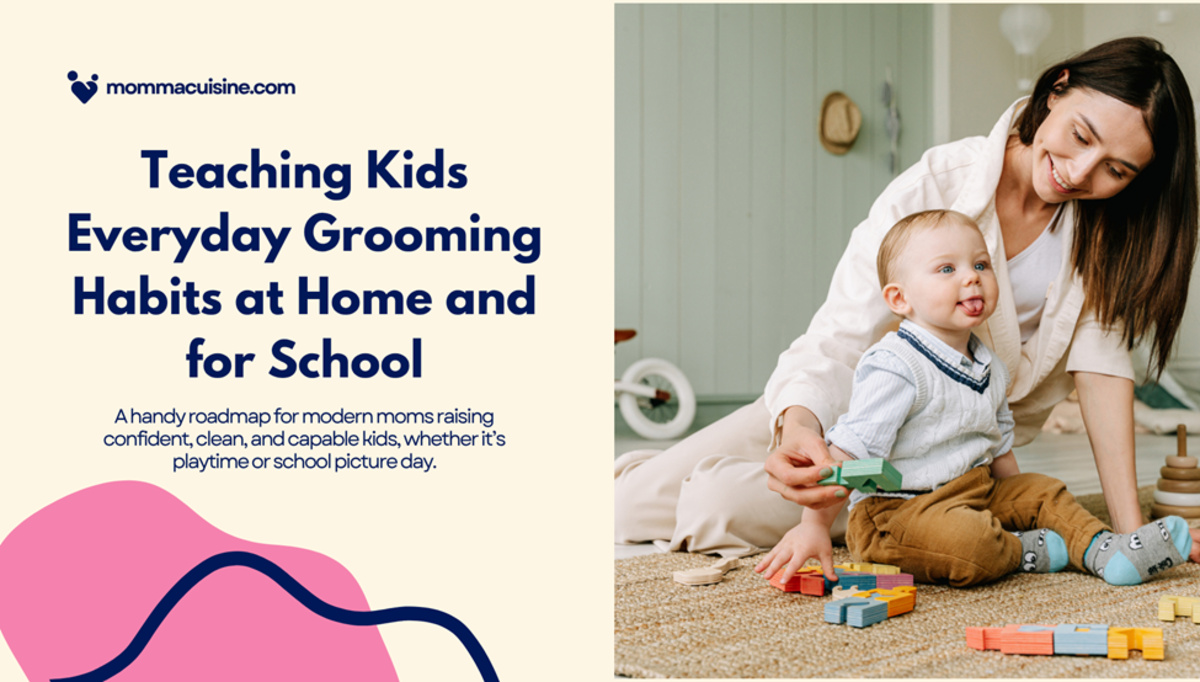Blog
From Couch to Classroom: Teaching Kids Everyday Grooming Habits at Home and for School
As parents, we spend a lot of time
preparing our kids for life, academically, emotionally, and socially. But the
most important ones are the little everyday habits that shape how our children
feel about themselves.
Grooming isn’t just about staying clean;
it’s about building confidence, responsibility,
and independence. Whether they’re lounging on the couch or buttoning up a
school uniform, helping your child take pride in their appearance lays the
foundation for lifelong self-care.
This guide will explore age appropriate
strategies to teach your kids grooming habits that stick from casual routines
at home to polished looks for the school day.
Why grooming matters for kids (Yes, even
young ones)
Grooming habits go beyond hygiene, and
earlier the better. They’re about:
●
Developing self-respect and
self-esteem
●
Feeling prepared for social and
academic environments
●
Learning routines that support
structure and responsibility
When kids know how to care for
themselves, brushing their hair, cleaning their face, or tucking in a shirt;
they show up more confidently. And when those habits are learned young, they’re
more likely to stick as they grow.
Grooming at home: Building the basics
The best foundation for grooming habits
starts at home. Here’s how to guide kids of all ages through daily routines in
a way that feels natural and age-appropriate, not overwhelming or forced.
1. Start Simple
(and make it fun)
For toddlers and preschoolers, use
visuals or songs to teach grooming steps:
●
Brush teeth in little circles,
just like we stir soup!
●
Let’s wash hands like we’re
getting ready for a dance party.
Quick checklist for ages 2–5:
●
Wash hands before meals and after
potty
●
Brush teeth morning and night
(with help)
●
Comb hair after waking up
●
Change into clean clothes daily
2. Make grooming
a choice, Not a chore
●
Use encouraging language like:
●
Do you want to brush your teeth
before or after you put on your pajamas?
●
Should we use strawberry or
watermelon shampoo today?
This teaches autonomy while still getting
the job done.
3. Build visual
routines
Kids thrive on structure and creative
visuals. Try a simple chart for morning and bedtime:
- Brush teeth
- Comb hair
- Wipe face
- Change clothes
Printable versions (with stickers!) can
help younger kids feel accomplished.
Getting ready for school: Clean,
polished, and proud
School brings another layer of grooming
expectations; uniforms, cleanliness, and peer interactions. Here’s how to prep
your child without overwhelming them.
1. Uniform Ready = Confidence ready
Wearing a uniform doesn’t mean kids can’t
express pride in their appearance. Teaching them how to keep shirts tucked,
collars neat, and shoes polished gives them a sense of ownership. Make it
easier to get them excited for the school day by letting them help choose their
outfit.
You can even explore age-appropriate
wardrobe staples together like when you shop boys school uniform dress shirts that are comfy,
durable, and easy to care for. Premium brands like French Toast offer even more
thoughtful details: wrinkle-resistant fabrics, reinforced stitching, stretch
collars for comfort, and easy-care finishes that survive busy school weeks.
Their designs balance everyday
practicality with a polished look, helping kids feel confident and school-ready
from the first bell.
Pro tip: Let
them help prep their uniform at night; laying it out teaches responsibility and
avoids morning meltdowns.
2. Focus on the
feel, Not just the look
Kids may not care about “neatness”; but
they care about comfort. Frame grooming like this:
-
Brushing your hair keeps it out of
your eyes so you can focus in class.
-
Washing your face helps you feel
fresh and awake before school.
Linking grooming to how they feel (not
how they “should” look) builds internal motivation.
3. Build a
morning checklist (That actually works)
Avoid chaos with a visual schedule that
includes:
●
Teeth brushing
●
Face washing
●
Hair grooming
●
Putting on uniform
●
Packing a small self-care kit
(comb, lip balm, deodorant if age-appropriate)
Include breakfast or hydration reminders
because a polished outside starts with good care inside, too.
Teaching grooming through connection,
Not control
No one likes being told what to do every
day; especially kids. Here’s how to make grooming a shared experience, not a
battle of wills.
1. Model
what you want to see
Kids mirror behavior. If they see you
flossing, moisturizing, or ironing your clothes, they absorb those habits as
normal; not optional.
Talk through your routine out loud:
●
“I’m using this lotion to keep my
skin soft.”
●
“I check my collar in the mirror
to make sure it’s flat.”
This builds grooming literacy from a
young age.
2. Use
“when/then” routines
Instead of nagging, try:
“When you’ve brushed your hair, then we
can go outside.
“When your shoes are on the rack, then
tablet time starts.”
It teaches sequencing and accountability
without turning you into the villain.
3.
Celebrate progress, Not perfection
Praise effort:
“I noticed you remembered to wipe your
face all on your own this morning; amazing!”
“Your uniform is looking sharp today.
You’re really taking care of it!”
Avoid overcorrecting minor things. The
goal is confidence, not compliance.
Tailoring grooming to age + stage
Here’s a quick guide to help moms know
what’s age-appropriate and when to nudge kids toward more independence. Every
child develops differently. Focus on progress over age benchmarks.
|
Age Group |
Focus Areas |
Tools & Tips |
|
2–4 yrs |
Basic hygiene, visual checklists, parental guidance |
Fun brushes, step stools, sticker charts |
|
5–7 yrs |
Toothbrushing, basic haircare, dressing neatly |
Choose-your-outfit nights, routine posters |
|
8–10 yrs |
Independent routines, learning to prep uniforms |
Beginner deodorant, mirror checks, chore charts |
|
11–13 yrs |
Personal grooming choices, body care |
Face wash, skincare, conversations about hygiene & self-respect |
Quick wins: Kid friendly grooming products that help
Pairing grooming with products kids enjoy
can boost follow-through. Favorites:
●
Electric toothbrushes with timers
●
Tear-free shampoos in fun scents
●
Detangling sprays and colorful
combs
●
Kid-safe skincare (gentle face
wash, sunscreen sticks)
●
Mini deodorants for preteens
learning body care
Tip: Let them pick their tools at the
store or online; buy-in increases when they feel ownership.
Final Thought: Grooming is a life skill; Not just a To-do
list
Helping your child learn how to care for
themselves isn’t about making them “look good”; it’s about helping them feel
good.
These everyday routines build
self-esteem, encourage independence, and give them tools they’ll use for a
lifetime.
So whether it’s wiping peanut butter off
their face before preschool or making sure their school collar is straight,
remember: you’re not just raising a clean kid; you’re raising a confident one.





Comments